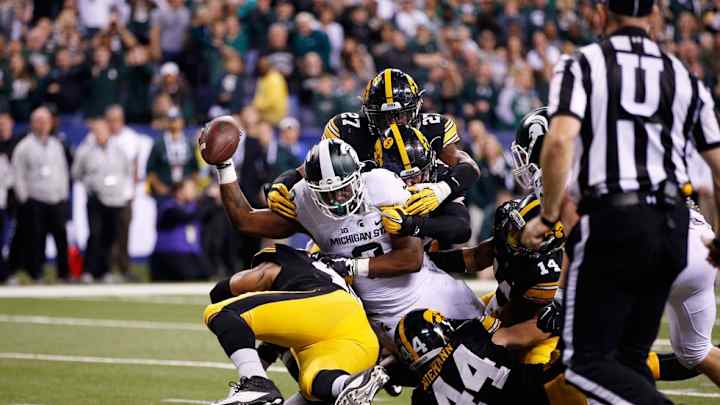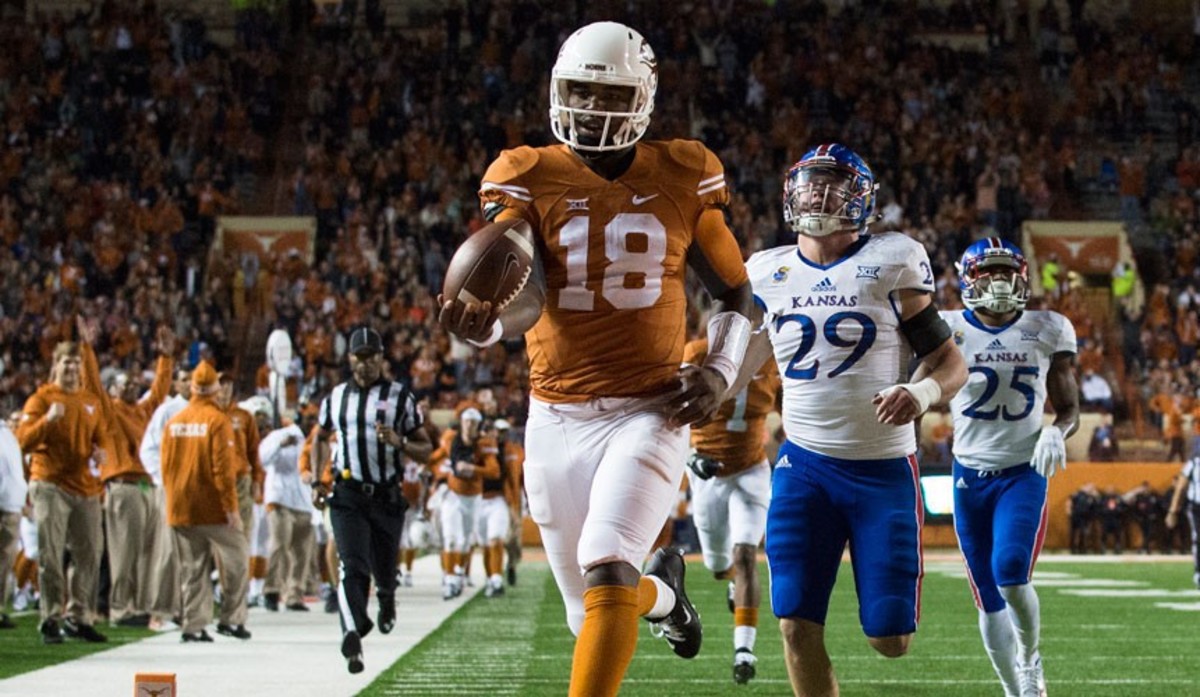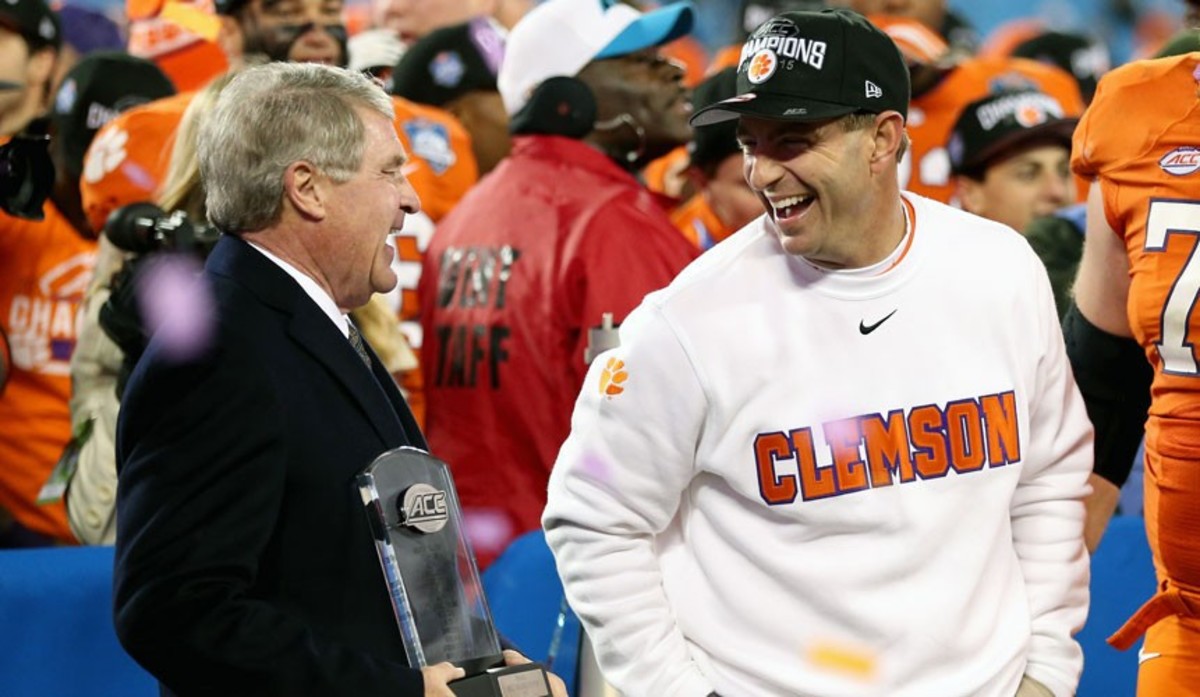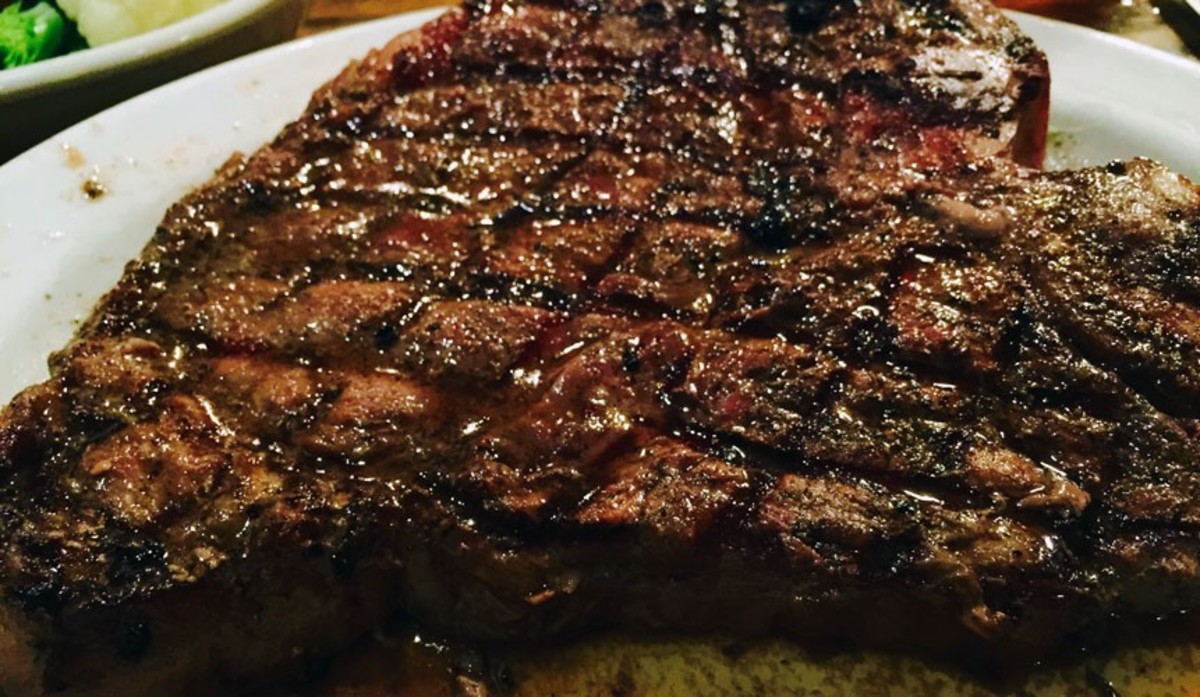The future of college sports media rights: How will deals evolve with the landscape? Punt, Pass & Pork

[video: 13724933]
Within the next year, we should get a peek at the future of how we will get our sports on television. The networks and three of the Power 5 conferences will have to make decisions that should offer clues about how we should expect to watch sports in 2026. The world of cable television and rights fees has changed considerably since schools tore up the conference landscape in the Great Cash Grabs of 2010 and '11, and we may find that the ecosystem the schools created in that round of realignment is only temporary.
The Big Ten, Big 12 and ACC are all in the process of discussing media rights contracts. (It simply is not correct to call them "TV deals" anymore.) Only one of those leagues (the Big Ten) actually has any rights up for sale, but the talks in the Big 12 and ACC should shed further light on where everything is going.
Let's break down the possibilities for each league.
Big Ten
John Ourand and Michael Smith of the Sports Business Journal, who cover this topic better than anyone, reported last week that the Big Ten has begun accepting bids for its first-tier rights starting in 2017. For the past five years, we've assumed a bidding war between ESPN, Fox and possibly CBS or NBC would create an astronomical payday for the conference. After all, these will be the last major American sports rights—college or pro—available until at least 2020. Demand is high. Supply is low. That's a recipe for a huge price tag. The Big Ten will far outpace the 10-year, $1 billion deal it currently has with ESPN for its best football and most of its best basketball games.
But here's the problem: In locking down all of those other rights deals, the networks have dramatically increased their overhead at a time when they are hemorrhaging subscribers. Sports atheists are rapidly realizing that half of their cable bill pays for programming they don't care about, so they're cutting the cord. Add in younger "cord nevers," recent high school and college graduates who barely remember a television world that wasn't a la carte and on demand, and it becomes risky for networks to commit too much money without having a clear idea what revenues will look like in the not-so-distant future. ESPN has reportedly lost seven million subscribers over the past two years. Assuming those people only had ESPN and none of the network's other channels—most likely did, but let's estimate conservatively—that's seven million people who are no longer paying $6 a month for ESPN. That's a loss of $42 million a month, or $504 million a year.
ESPN's deals with carriers are designed to bump subscription fees every so often, so that could offset some of the loss. But even for a financial behemoth like ESPN, losing half a billion a year in what had previously been reliable revenue has to be unsettling—especially when the network has a reported average of $1.9 billion a year committed to the rights for Monday Night Football and a reported $1.4 billion a year committed to NBA rights when the new deal kicks in next season.
If this were 2013, when the cable bundle felt as if it would stay intact for much longer, ESPN could throw money at the Big Ten for two reasons: The rights are valuable, and an exclusive deal for the league's first-tier rights would essentially choke out Fox and ensure that all of the best college games aired on ESPN networks. Under that scenario, the amount of money would extend into the ludicrous, as Fox would counter with a huge amount because it needs those games to attract viewers. In-demand live sporting events drive viewership. Sports fans have been trained by three decades of dominance to default to ESPN. How did ESPN come to dominate? It hoarded college football and basketball rights when they were cheap and broadcast games nationally that might not have even been broadcast locally before.
STAPLES: Lovie Smith hire shows bolding thinking of new Illinois AD
Fox Sports 1 boss Jamie Horowitz thinks he can earn a greater audience share by offering more Baylessian blazing hot takes, but the only effective way for Fox to break viewers' ESPN habit is to air an event along the lines of a Michigan-Ohio State game. (Of course, Fox would probably show that on its broadcast network and not Fox Sports 1, which would negate the desired gains.) This mega-bidding war likely won't happen for two reasons. First, networks will be constrained by the economic factors described above. Second, Big Ten commissioner Jim Delany may want to split up the rights. He has fought his battles with ESPN, but he also knows the Worldwide Leader can stop talking about a conference that doesn't appear on its air. Meanwhile, Fox owns 51% of the Big Ten Network, so it is a valuable partner. Given NBC's predilection to stick with sports no competitor carries (English Premier League soccer and Formula One, for example) and CBS's relatively conservative approach to rights—why risk money up front when you can plug in
NCIS: Prague and deliver numbers?—ESPN and Fox will likely be the high bidders. (Though don't be shocked if CBS extends its deal for some of the better basketball games at a higher price than the $12 million a year it pays now. Those games provide a good dry run for the people who broadcast the NCAA tournament.) And those bids will be high. The Big Ten will still probably double or even triple the previous deal and cement itself as the highest-grossing conference in college sports.
The big question with the Big Ten is how long the deal lasts. Will the league try to lock down the largest payout for the longest time possible from an industry that appears to be in decline? Or will it opt for a shorter deal that expires around the same time as the deals in the other Power 5 leagues? The cable industry in 2016 feels a little like the newspaper industry in 2000. Technology has provided a better, cheaper way to distribute this content, so how long will consumers keep paying the amount they pay now? For newspapers, the dropoff was precipitous. ESPN executives seem more forward-thinking than their newspaper brethren and have certainly built the infrastructure to compete in an over-the-top, streaming world. Yet the days of giant, reliable subscription revenue may end and never return.
By 2027, when the ACC's deal expires, many—if not most—of us will get programming through our Internet connections. Gigabit connectivity is sprouting up across the nation. In 11 years we won't need a cable or satellite service to provide a perfect picture. We'll pay someone else for programming. The question is who. Will leagues want to bother with a middleman? At that point, it may be more profitable for some to simply sell their games directly to consumers via a streaming app that can be accessed on any device. Or maybe the streaming services will snap up live sports rights to bolster subscription bases. Netflix content chief Ted Sarandos told a crowd at a media conference in December that the only way the company would get into sports is to own and operate the events instead of licensing them from a league. But that's now. What about in 10 years? Ten years ago, Netflix's core business was through-the-mail DVD rental. This particular world keeps changing fast.

Cooper Neill/Getty Images
Big 12
Oklahoma president David Boren has been outspoken about his desire for the league to add two schools and for Texas to give up on the Longhorn Network and allow ESPN to use that bandwidth to launch a Big 12 Network. Last week, Oklahoma State football coach Mike Gundy joined the anti-Longhorn Network chorus. In an interview with Dennis Dodd of CBSSports.com, Gundy called the Longhorn Network "a failure." "If we don't eliminate the Longhorn Network and create our own network, they're going to continue to have issues with this league," Gundy told Dodd.
For those who don't remember, the Longhorn Network is one of the main reasons the Big 12 still exists. Texas, Texas A&M, Texas Tech, Oklahoma, Oklahoma State and Colorado were headed to the former Pac-10, but then the Longhorns pulled an 11th-hour okey-doke on commissioner Larry Scott when the schools out west wouldn't agree to let Texas form its own television network. So, the Longhorns made nice with the rest of the Big 12 and got their network. That network has been a pain for ESPN. Distribution required a fight at every step. Subscriber fees—a reported 29 cents a month in Texas and less elsewhere—remain low. It has been fine for Texas, though. Though it may be the butt of nobody's-watching jokes, the Longhorn Network kicks some serious coin into the school's bank account. Texas's 20-year deal with ESPN guarantees an average of $15 million a year.
The thinking by Boren, Gundy and others in the league is that if Texas were to agree to give up the Longhorn Network—while being made financially whole for its trouble—ESPN could turn Bevo TV into the Big 12 Network. Texas officials have been tight-lipped about the possibility, but it makes sense that former U.S. Senator Boren would use his considerable political skills to put pressure on rookie Texas athletic director Mike Perrin and rookie Texas president Greg Fenves. But a few nagging questions remain.
• Would this really be a better deal in the long run?
ESPN would probably be thrilled with a different arrangement. Adding Oklahoma, Oklahoma State, Baylor and the like into the fold would appeal to more people in a larger geographic footprint. That would increase subscribership and allow for a larger subscriber fee. The network wouldn't have to convince carriers to add a channel number; the Longhorn Network distribution fight is mostly over.
However, the other Big 12 schools have already sold their third-tier rights. Kansas split them between Time Warner Cable and ESPN. Oklahoma sold its third-tier TV rights to Fox in 2012 for $58 million over 10 years. In '13, West Virginia sold its third-tier television rights as well as radio and multimedia rights to IMG College for at least $80 million over 12 years. A new ESPN deal would require the untangling of those deals, and given that Texas would get a disproportionate amount of the take, there is no guarantee the other schools would make more. If we lived in the '11 universe, they would. But cable isn't such a sure thing in '16.
Every conference wants a network like the SEC's, which has done nothing but churn out cash for the league and boost ESPN's bottom line. But that success is a result of regional circumstances and loyalties that are not comparable elsewhere. Yes, that's a nice way of saying that SEC fans care more about their teams than other fan bases. At this point, that isn't an opinion. It's a fact proven by the terror among cable and satellite companies who added the SEC Network at a whopping price ($1.40 per subscriber in SEC territory) since so many people threatened to changes services if they didn't. No other conference can pull that off.
• What's in it for Texas?
That's what the Longhorns officials must decide. Big 12 stability isn't nearly as important to them as it is to executives at Oklahoma State or Kansas State because if the Big 12 breaks up, the commissioners of the other leagues will trip over one another trying to get to Austin. The Big 12's history is full of stories of athletic directors and coaches getting mad at Texas because of disproportionate revenue sharing prior to the current arrangement. To make this work financially for Texas, the Longhorns have to get more from the network. Will the other schools be able to handle that? They may say they can now, but they also said they were fine with the Longhorn Network until the Longhorn Network actually existed.
So, what's the incentive for Texas? If the only answers are Big 12 harmony and/or stability, it's time to start looking for some better ones.

Streeter Lecka/Getty Images
ACC
Discussions for a dedicated ACC Network began about four years ago, yet no such channel appears on any cable system. It is supposed to launch by next year, but in November the Atlanta Journal-Constitution's Ken Sugiura reported that Georgia Tech president Bud Peterson told his athletic board that ESPN wanted a delay. "[ESPN] had come back and said that in some of the other instances where [conference] networks have started, they lost considerable amounts of money in the first couple of years," Peterson said, according to the paper. "What they'd like to do is delay the start for a couple years and do the necessary preparation."
ACC commissioner John Swofford called those comments "premature and speculative" at the time, and given that Swofford is a ninja, it's quite possible everything is on track for an on-time launch. Still, the longer the delay, the less likely a traditional cable network ever happens for all the reasons described above. Now is bad time to start a cable network. By 2018, the cable universe may have reached a point where no one is starting a new network.
NIESEN: FSU's Dalvin Cook is arguably the top running back in the nation
The good news for the ACC is it will make more money from ESPN—which owns all of its rights—whether it launches a network or not. Check out
the last line of this quote Swofford gave last summer to David Teel of The Daily Press from Newport News, Va. "If we're going to do this, we need to do it in the right way from the beginning that gives us the opportunity to have long-term success, and that's what we're trying to do and time it in a way so the distribution can be good, if not great, coming out, if we go this route," Swofford said. "The other alternative is larger rights fees [from ESPN]." That lines up with something frequent ACC play-by-play man Wes Durham said during an interview with a Louisville radio station earlier this month—then quickly walked back—about a clause in the league's rights deal that would result in more cash for the conference from ESPN if a network doesn't launch.
The ninja wasn't going to do a deal where his league didn't get paid. So, what happens with the network? The only likely home for it in the cable universe is where ESPN News sits. ESPN News was created for people who wanted access to highlights and scores 24 hours a day. But ESPN has a far better delivery system for highlights and scores, and it allows viewers to get what they want immediately and without a TV. It's called ESPN.com. So, ESPN News is expendable, but it seems more likely any ACC Network will be a multi-platform arrangement. This would better position it for a future in which everything will be streamed. Plus, the current ACC digital offerings created by a Chicago-based tech company called Silver Chalice are among the best in sports in terms of production value and ease of access. ESPN has a blueprint to follow if it chooses to go that direction.
It's difficult to predict exactly how any of this will shake out for these three leagues. But pay attention to how the conferences and networks handle these situations. The solutions should give us a better idea how we'll get our sports, and it might tip us off about how the conferences themselves might look going forward.
A random ranking
The six-year-old has dipped a toe into the Teenage Mutant Ninja Turtles universe because of ads for the upcoming movie. So, naturally, I went to YouTube and showed him the original cartoon so he could understand how much better things were when I was a kid. Here is the definitive ranking of the turtles.
1. Leonardo
2. Michelangelo
3. Donatello
4. Raphael
First-and-10
1. Mississippi State coaches and administrators must decide what to do after video surfaced last week of five-star signee Jeffery Simmons hitting a woman while the woman was on the ground. Simmons, a defensive end from Macon, Miss., took to Facebook on Saturday to apologize.
It will be interesting to see how the Bulldogs handle this situation. The SEC passed a rule last year that prevents member schools from accepting transfers who were booted from their previous school for domestic or sexual violence, but that rule doesn't apply here. Simmons isn't a transfer, and this isn't a domestic violence case. It's more similar to the 2014 case involving Oklahoma tailback Joe Mixon, who punched a woman during an argument at a restaurant.
Local law enforcement has taken no action, but the video shows Simmons punching the woman. In his apology, Simmons suggested he hit the woman because of something she said about his deceased nephews. Simmons also wrote in the Facebook post there are no excuses, and on that point he is correct.
A man should never strike a woman. I realize that's an old-fashioned and possibly chauvinistic viewpoint, but I'm not changing my mind on this. The question now is how coach Dan Mullen and the Mississippi State administration feel about it.
2. Ohio State athletic director Gene Smith did not need to apologize to anyone after unleashing a sick burn on the Buckeyes' rival last week and drawing a comeback from Michigan coach Jim Harbaugh. In fact, the Rivalry Smack Talk Treaty of 1948 suggests Smith should have fired back again.
To review, Smith quashed the idea of the Buckeyes' copying Harbaugh's spring-practice-in-Florida idea with a Steve Spurrier-level quip.
Gene Smith is against spring practice in FL: "If we were jump starting our program I'd probably try to do that too." https://t.co/226Yt18S6W
— Eleven Warriors (@11W) March 22, 2016
Harbaugh, who loves dishing out that sort of thing, responded in kind.
Good to see Director Smith being relevant again after the tattoo fiasco. Welcome back!
— Coach Harbaugh (@CoachJim4UM) March 23, 2016
Smith then responded with an unnecessary apology. It's sports. Rivalries are fun. Smith should have kept it going with something like this: Hope you got some sun in Florida, Jim. Good luck with the jump start. That 42–13 final last year suggests you still need one.
3. Speaking of Spurrier, he was named the winner of the Neyland Trophy last week. The award, given by the Knoxville Quarterback Club, will be presented at Tennessee's spring game on April 18 at Neyland Stadium. How will the crowd respond to the man who once reminded everyone that it's impossible to spell Citrus without UT?
Spurrier will probably be disappointed if Volunteers fans don't boo lustily.
Meanwhile, play-by-play legend Brent Musburger will also be honored at Tennessee's spring game. Here's hoping he tries to rope Spurrier into some prop bets when the third-stringers take on the fourth-stringers. Musburger's "friends in the desert" expect nothing less.
4. The Alabamafication of the Georgia football program continues, and now the state legislature is helping. Last week, an 11th-hour amendment was inserted into a bill changing the amount of time college athletic departments at state schools have to fill open records requests from three days to 90. The bill will go into law if Georgia Gov. Nathan Deal signs it. This only applies to college athletic departments. Frivolous entities such as the governor's office and other state agencies would still have to adhere to the three-day rule. But what really matters—how Georgia handles spending on its new indoor practice facility or how much it spends on private jet travel for recruiting—will be protected by three months of fresh red (and black) tape.
One of the bill's co-sponsors presumably kept a straight face for as long as it took to give a quote to the Atlanta Journal-Constitution. "It just allows us to play on the same field as Alabama and everybody else," Rep. Earl Ehrhart told the paper. With all due respect to the distinguished gentleman from Powder Springs, Georgia shouldn't be on the same field as Alabama until it can improve enough to avoid falling behind by 35 early in the third quarter. (That's kind of why it hired Kirby Smart from the Crimson Tide in the first place.) No legislative assistance will help the Bulldogs do that. But if it makes you feel better, clutch those records tight.
5. Derrick Willies is a 6' 3", 215-pound receiver who started his career at Iowa, transferred to a Texas juco and then signed with Texas Tech. If this weight-room video is any indication, Red Raiders quarterback Pat Mahomes should have some fun throwing to Willies.
6. New BYU coach Kalani Sitake danced into your timeline last week.
7. Sitake came to BYU from Oregon State, where second-year coach Gary Andersen is experiencing some attrition.
8. This explains so much.
9. Jake Allen, a class of 2017 quarterback committed to Florida, showed that he is ready for how the pocket will feel if the Gators' offensive line doesn't make strides between the end of last season and when he arrives.
10. James Franklin, perfect form tackler.
A 6'2" and extremely competitive Easter bunny at @coachjfranklin's house? Yup, that checks out. pic.twitter.com/ISCItB4qgG
— Penn State Football (@PennStateFball) March 26, 2016
What's eating Andy?
Don't you hate when the testicles you ordered aren't what you expected? Read on to find out more.
What's Andy eating?
Half of finding happiness is properly setting your expectations. You shouldn't watch a Michael Bay movie and expect rich character development. You shouldn't buy store-brand liquor and expect to wake up without a hangover. You also shouldn't go to a steakhouse where the average steak costs $25 and expect the same beef you would get at Morton's or Ruth's Chris for twice the price.
That's the problem some people encounter when they go to a place like Cattlemen's, the Oklahoma City institution that originally opened in 1910 to serve the workers driving cattle into the nearby stockyards. If you think that $30.75 T-bone is going to taste like the one you got at your local red-velvet steakhouse for $59*, you will be sorely disappointed. If you arrive with the proper expectations—a decent steak surrounded by kitschy decor and people who aren't wearing cowboy hats ironically—you'll leave full and happy.

Andy Staples
*I'm getting the bone-in ribeye at most of those places—with one notable exception**—but that isn't an option on the Cattlemen's menu.
**That exception would be Charley's in Tampa and Orlando. It's the home of the 20-ounce Fabulous Filet. One per loin. Two per steer. Order it rare. Thank me later.
Steak is the ultimate get-what-you-pay-for food. Restaurants make the slimmest profit margins on meat. At prime steakhouses, they hope you load up on ridiculously priced sides or wine. At a place like Cattlemen's—or its mass-appeal descendants Texas Roadhouse and Logan's Roadhouse—they give you a salad and delicious bread and hope you load up appetizers and booze. At Cattlemen's, they probably pray you order the lamb fries.
What's a lamb fry? It's a fried lamb testicle. I had never eaten testicles of any kind before my visit to Cattlemen's, so I have no basis for comparison. I can only surmise what happened based on the plate of heavily battered gonads and the miniature swimming pool of watery cocktail sauce set before us. Either these weren't the most virile lambs or Cattlemen's was heavily battering only tiny shards of lamb family jewels to goose the profitability of the $9.95 appetizer.

Andy Staples
I should have skipped the lamb fries and offered to pay for extra rolls. Those were tremendous, especially when dipped in the juices of a T-bone. The steak was cooked exactly as I'd ordered it (rare, preferably still mooing) and simply seasoned. A good cut of beef doesn't need much help, and the cooks at Cattlemen's didn't go crazy trying to coach up a steak that arrived with a near-perfect skill set.
Had I gone in expecting Mercedes performance at Ford prices, I may have left Cattlemen's feeling shorted. Instead, I left with a story about testicles and a belly full of beef. These days, that's pretty much all I could expect for less than $50.
